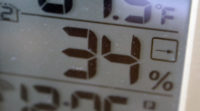The Army Research Lab (ARL) in Adelphi, Md., found this recently. The facility is going through a series of programs to improve its energy efficiency. One step called for installing an onsite generator and using the waste heat to replace the boiler generated hot water. But the boiler was also producing steam to humidify some of the laboratory’s clean rooms.
By replacing the steam humidification system with a Meefog humidification system, the ARL was able to go ahead with its cogeneration plans and found a way to reduce energy and maintenance costs at the lab’s other buildings.
Blowing Off Steam
The ARL is the primary tenant of the Adelphi Laboratory Center (ALC), a 207-acre facility in the northwest Washington, D.C., suburb of Adelphi, Md. The ALC has 37 buildings, more than a million square feet total, containing research and laboratory space, explosives storage, utility plants, maintenance yards, fabrication shops, and administrative offices.
One of those 37 is the Zahl Physical Science Laboratory. Built in the 1990s, the 375,000-square-foot Zahl Building houses research into areas such as sensors, batteries, and microelectronics devices, which are used in military detection and weapons systems. Tom Bradford was with the Army Corps of Engineers during the Zahl Building construction and was asked to stay on after its completion. He is now chief of the ARL’s Engineering Division in the Directorate of Public Works.
Originally the Zahl Building had media type evaporative humidifiers, and these were good enough for most purposes. But then the building added U.S. Federal Standard 209E Class 10 and Class 100 clean rooms (equivalent to ISO Class 4 and Class 5). Together the clean rooms are 105,000 square feet and require 60,000 cfm of 100 percent outside air to fully exhaust any particles or fumes from the rooms. At that point, the evaporative humidification was no longer adequate to meet the wintertime requirements.
“The clean room makeup air handlers are based around a 40°F supply air temperature, and it is difficult to get the water to evaporate from the fill at that temperature,” said Bradford. “When the Class 10 clean room was added, a modification was made to change over to steam, but it turned out after commissioning that during some very cold and dry seasons, that steam humidification was inadequate.”
Switching to CHP
Like most organizations, the ARL is interested in doing whatever it can to cut its energy usage. While there are plenty of good reasons to consume less fuel, nothing beats saving on the utility bill so that money can be put to other uses.
The ARL’s approach is to engage in a series of energy savings performance contracts (ESPC), where a contractor will line up financing for the efficiency improvements, and then get paid back over time out of the energy cost savings. ESPC 1 included replacing the boiler, installing high-efficiency lighting, and improving the energy management control system. Ameresco Inc. won the second ESPC, which covered a wide range of actions, including improvements to the boiler controls, the compressed air system, and the chilled water plant, and installing skylights and high-efficiency transformers.
Ameresco hired American Combustion Industries Inc. (ACI) to execute one of the major projects of ESPC 2, retrofitting the central utility plant with a combined heat and power (CHP) cogeneration system. ACI removed the existing high temperature hot water generator and the existing chiller and installed two 1.1 MW Waukesha natural gas reciprocating combustion engines together with heat exchangers, heat recovery boilers, circulating pumps, and other ancillary equipment. The CHP project began in February 2010 and was finished the following February.
The CHP system is designed to operate year round, replacing part of the 6 MW that the ARL normally purchases from the local utility, PEPCO. Tim Ngo, an engineer in the Directorate of Public Works who was project manager for some of the ESPC 2 actions, said that the heat recovered from the generators is used year round to provide process hot water as well as for heating the buildings — even in the summer, due to the stringent humidity requirements, reheat is used for most of the buildings.
The CHP system went on-line in early 2012, but Ngo says that because of the low demand for hot water, only one engine is run at a time. Without the need for hot water, it is cheaper to purchase power from the grid.
Efficient Humidification
There was one problem that had to be resolved, however, before switching over to the CHP system. The old high temperature hot water (HTWH) system operated at 400°, which was hot enough to produce steam to humidify the Zahl Building clean rooms. The CHP hot water system operates at 250°, hot enough for process water, but not enough for steam humidification. The boilers could be kept on-line to provide the necessary steam, but it would be expensive to run them just to humidify the labs, slashing the savings the ESPC was supposed to produce.
To address this issue, Ameresco and the ARL opted to go with a Meefog humidification system from Mee Industries Inc., Irwindale, Calif. The fog system uses a high pressure pump to direct water to an array of impaction pin nozzles in the air handler. These nozzles atomize the stream of water into billions of droplets which quickly evaporate in the air stream, raising the humidification to the desired level. Although the clean rooms originally used media type evaporative coolers, Bradford said that the system is different in that it breaks the water into such tiny droplets that the surface to volume ratio of the water is high enough to allow rapid evaporation, even during the winter.
“The Meefog presents a lot more surface area of water to the air, which makes it easier to evaporate,” said Bradford. “It is much more difficult to get the air to absorb the water from a media evaporative humidifier.”
ARL purchased two Meefog systems. For makeup air unit (MAU) 1, there is a 5 hp duplex pump with a backup (N+1) providing 1,512 lbs. of moisture per hour. For MAU-2, there is a 3 hp duplex pump system (also N+1) providing 739 lbs./hr. These systems use water from the lab’s deionized water system and so a section of each air handler needed to be lined with stainless steel.
“Deionized water was used because the clean rooms need to have very clean water put in the air,” said Bradford. “If we did put a lot of calcium or phosphates into the air, it would load up the HEPA filters pretty quickly.”
Moving onto the Next Phase
With the new fog systems in place, the ARL was able to cap off the steam lines and shut down the boiler. The fog systems proved to cost less to operate and maintain than the steam humidifiers. Although the CHP plant just came on-line in mid-year, ARL estimates FY 2012 savings of $127,000.
ARL is now getting ready for ESPC 3, which in addition to rainwater harvesting and photovoltaic generation includes replacing steam with further fog systems in another 20 air handlers.
“The boilers are old and tired, they have failed or are failing, and they are quite expensive to keep running,” said Bradford. “From an O&M standpoint, we prefer the Meefog system.”
For more information, visit www.meefog.com.
Publication date: 8/19/2013
Want more HVAC industry news and information? Join The NEWS on Facebook, Twitter, and LinkedIn today!








